South Carolinaâs state veterinarian has confirmed the first 2015 case of Eastern Equine Encephalitis (EEE) in the state in 2015. An unvaccinated horse died from the disease in Barnwell County this past week.

Mosquito - Carrier of Eastern Equine Encephalitis virus
South Carolinaâs state veterinarian has confirmed the first 2015 case of Eastern Equine Encephalitis (EEE) in the state in 2015.
Eastern Equine Encephalitis is transmitted to horses by mosquitoes that have fed on infected wild birds. EEE occurs in a wide variety of songbirds, including the blue jay, chickadee, cardinal, tufted titmouse and catbird. Mosquitoes that inhabit marshes and wooded wetlands, named Culiseta melanura,transmit the virus from bird to bird and also to horses and people.
Symptoms include
- Fever
- Sleepy appearance
- Muscle twitches in head, neck, shoulder and flanks
- Staggering gait
- Recumbency
The fatality rate is 90% or higher and an animal that survives the disease may have brain damage.
Other diseases and poisoning may have similar symptoms. It is important that a speedy diagnosis is made. A veterinarian can take blood samples to send to a diagnostic laboratory.
Prevention
Annual vaccination of all horses and other equines is recommended. Horses vaccinated for the first time must receive an injection of EEE-WEE combined vaccine, followed by a second dose three to four weeks later.
The two-dose series is necessary to establish an effective immune response. If an outbreak occurs in the area, a second booster is advised.
Foals should be vaccinated at 4, 5, and 6 months of age for a total of three doses. Another booster should be given in six months and annually from then on.
In addition to making sure that all equines are vaccinated, horses should be taken in at times when the mosquito population is highest. This usually includes the hours around dawn and dusk. In some cases, horses can be blanketed or covered with protective gear to prevent bites. Insect repellant can be used on horses to prevent bites from mosquitoes.
In all cases, the population of mosquitoes should be controlled as much as possible by following the recommendations of mosquito-control personnel and the agencies in the area where horses are kept.
Any bodies of stagnant water should be drained and water-holding containers such as buckets, tires and other receptacles where water might accumulate should be emptied. Horse troughs and waterers should be flushed often to reduce mosquitoes near paddock areas.
Insecticides for treating mosquito nesting areas around homes and livestock premises should be used on a regular basis.
Treatment
There is no specific treatment for EEE. Antibiotics are not effective against viruses, and no effective anti-viral drugs have been developed.
